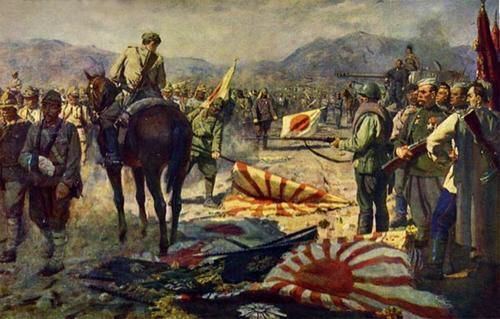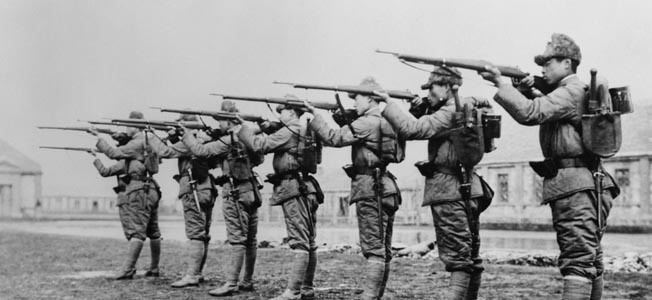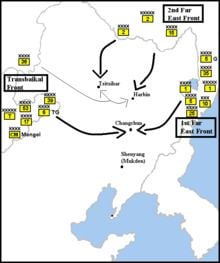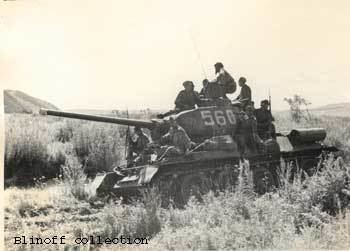Dates 9 Aug 1945 – 20 Aug 1945 | ||
Soviet Union1,577,725 troops27,086 artillery pieces1,152 rocket launchers5,556 tanks and self-propelled guns3,721 aircraftMongolia16,000 troops Japan713,729 troops5,360 artillery1,155 tanks1,800 aircraft1,215 armored vehiclesManchukuo170,000 troopsMengjiang44,000 troops Soviet Union11,033 killed24,125 wounded300+ tanks destroyedMongolia72 killed125 wounded Japan21,389 killed20,000 woundedunknown troops capturedMuch equipment capturedManchukuoMost troops deserted beforehandMengjiangMost troops deserted beforehandSoviet claim 83,737 killed Combatants Similar World War II, Soviet–Japanese War, Mariana and Palau Islands c, Second Sino‑Japanese War, Borneo campaign | ||
Russian beach assault soviet invasion of manchuria men of war assault squad 2 gameplay
The Soviet invasion of Manchuria, also known as the Manchurian Strategic Offensive Operation (Манчжурская стратегическая наступательная операция, lit. Manchzhurskaya Strategicheskaya Nastupatelnaya Operaciya) or simply the Manchurian Operation (Маньчжурская операция), began on 9 August 1945 with the Soviet invasion of the Japanese puppet state of Manchukuo. It was the last campaign of the Second World War, and the largest of the 1945 Soviet–Japanese War which resumed hostilities between the Soviet Union and the Empire of Japan after almost six years of peace. Soviet gains on the continent were Manchukuo, Mengjiang (Inner Mongolia) and northern Korea. The Soviet entry into the war and the defeat of the Kwantung Army was a significant factor in the Japanese government's decision to surrender unconditionally, as it made apparent the Soviet Union would no longer be willing to act as a third party in negotiating an end to hostilities on conditional terms.
Contents
- Russian beach assault soviet invasion of manchuria men of war assault squad 2 gameplay
- Summary
- Soviets
- Western Front of Manchuria
- Eastern Front of Manchuria
- Northern Front of Manchuria
- Japanese
- Campaign
- Aftermath
- War crimes
- References

Since 1983, the operation has sometimes been called Operation August Storm (mainly in the United States), after U.S. Army historian David Glantz used this title for a paper on the subject.

Summary

As agreed with the Allies at the Tehran Conference in November 1943 and the Yalta Conference in February 1945, the Soviet Union entered World War II's Pacific Theater within three months of the end of the war in Europe. The invasion began on 9 August 1945, exactly three months after the German surrender on May 8 (9 May, 0:43 Moscow time).

Although the commencement of the invasion fell between the American atomic bombings of Hiroshima, on 6 August, and only hours before the Nagasaki attack on 9 August, the timing of the invasion had been planned well in advance and was determined by the timing of the agreements at Tehran and Yalta, the long term buildup of Soviet forces in the Far East since Tehran, and the date of the German surrender some three months earlier; on August 3, Marshal Vasilevsky reported to Premier Joseph Stalin that, if necessary, he could attack on the morning of 5 August.
At 11pm Trans-Baikal (UTC+10) time on 8 August 1945, Soviet foreign minister Vyacheslav Molotov informed Japanese ambassador Naotake Satō that the Soviet Union had declared war on the Empire of Japan, and that from August 9 the Soviet government would consider itself to be at war with Japan. At one minute past midnight Trans-Baikal time on 9 August 1945, the Soviets commenced their invasion simultaneously on three fronts to the east, west and north of Manchuria:
Though the battle extended beyond the borders traditionally known as Manchuria—that is, the traditional lands of the Manchus—the coordinated and integrated invasions of Japan's northern territories has also been called the Battle of Manchuria. It has also been referred to as the Manchurian Strategic Offensive Operation.
Soviets
The Far East Command, under Marshal of the Soviet Union Aleksandr Vasilevsky, had a plan to conquer Manchuria that was simple but huge in scale, calling for a massive pincer movement over all of Manchuria. This was to be performed by the Transbaikal Front from the west and by the 1st Far Eastern Front from the east; the 2nd Far Eastern Front was to attack the center of the pocket from the north. The only Soviet equivalent of a theater command that operated during the war (apart from the short-lived 1941 "Directions" in the west), Far East Command, consisted of three Red Army fronts.
Western Front of Manchuria
The Transbaikal Front, under Marshal Rodion Malinovsky, included:
The Transbaikal Front was to form the western half of the Soviet pincer movement, attacking across the Inner Mongolian desert and over the Greater Khingan mountains. These forces had as their objectives firstly to secure Mukden (present day Shenyang), then to meet troops of the 1st Far Eastern Front at the Changchun area in south central Manchuria, and in doing so finish the double envelopment.
Amassing over one thousand tanks and self-propelled guns, the 6th Guards Tank Army was to serve as an armored spearhead, leading the Front's advance and capturing objectives 350 km (220 mi) inside Manchuria by the fifth day of the invasion.
The 36th Army was also attacking from the west, but with the objective of meeting forces of the 2nd Far Eastern Front at Harbin and Tsitsihar.
Eastern Front of Manchuria
The 1st Far Eastern Front, under Marshal Kirill Meretskov, included:
The 1st Far Eastern Front was to form the eastern half of the pincer movement. This attack involved the 1st Red Banner Army, the 5th Army and the 10th Mechanized Corps striking towards Mudanjiang (or Mutanchiang). Once that city was captured, this force was to advance towards the cities of Jilin (or Kirin), Changchun and Harbin. Its final objective was to link up with the forces of the Transbaikal Front at Changchun and Jilin thus closing the double envelopment movement.
As a secondary objective, the 1st Far Eastern Front was to prevent Japanese forces from escaping to Korea, and then invade the Korean Peninsula up to the 38th parallel, establishing in the process what later became North Korea. This secondary objective was to be carried out by the 25th Army. Meanwhile, the 35th Army was tasked with capturing the cities of Boli (or Poli), Linkou and Mishan.
Northern Front of Manchuria
The 2nd Far Eastern Front, under General Maksim Purkayev, included:
The 2nd Far Eastern Front was deployed in a supporting attack role. Its objectives were the cities of Harbin and Tsitsihar, and to prevent an orderly withdrawal to the south by the Japanese forces.
Once troops from the 1st Far Eastern Front and Transbaikal Front captured the city of Changchun, the 2nd Far Eastern Front was to attack the Liaotung Peninsula and seize Port Arthur (present day Lüshun).
Each front had "front units" attached directly to the front instead of an army. The forces totaled 89 divisions with 1.5 million men, 3,704 tanks, 1,852 self propelled guns, 85,819 vehicles and 3,721 aircraft. Approximately one-third of its strength was in combat support and services. The Soviet plan incorporated all the experience in maneuver warfare that they had acquired in fighting the Germans.
Japanese
The Kwantung Army of the Imperial Japanese Army, under General Otsuzo Yamada, was the major part of the Japanese occupation forces in Manchuria and Korea, and consisted of two Area Armies and three independent armies:
Each area army (Homen Gun, the equivalent of a Western "army") had headquarters units and units attached directly to the Area Army, in addition to the field armies (the equivalent of a Western corps). In addition, the Japanese were assisted by the forces of their puppet states of Manchukuo and Mengjiang. The former had an army of about 170,000 to 220,000 troops, while the latter had around 10,000, with the majority of these puppet troops being of dubious quality. Korea, the next target for the Soviet Far East Command, was garrisoned by the Japanese Seventeenth Area Army.
The Kwantung Army had over 700,000 men in twenty-five divisions (including two tank divisions) and six Independent Mixed Brigades. These contained over 1,215 armored vehicles (mostly armored cars and light tanks), 6,700 artillery pieces (mostly light), and 1,800 aircraft (mostly trainers and obsolete types). However, the Kwantung Army was far below authorized strength; most of its heavy equipment and all of its best military units had been transferred to the Pacific Theater over the previous three years to contend with the advance of American forces. They were also deployed against the Nationalist Chinese in Operation Ichigo. By 1945, the Kwantung Army contained a large number of raw recruits and conscripts, with generally obsolete, light, or otherwise limited equipment. Almost all of the tanks were early 1930s models such as the Type 95 Ha-Go and Type 89 I-Go, the anti-tank units only possessed Type 1 37 mm Anti-Tank Guns that were ineffective against Soviet armor, and the infantry had very few machine guns and no anti-materiel rifles or submachine guns. As a result, the Japanese forces in Manchuria and Korea had essentially been reduced to a light infantry counter-insurgency force with limited mobility or ability to fight a conventional land war against a coordinated enemy. In fact, only six of the Kwantung Army's divisions existed prior to January 1945. Accordingly, the Japanese considered none of the Kwantung Army's units to be combat ready, with some units being declared less than 15% ready.
The Imperial Japanese Navy did not contribute to the defense of Manchuria, the occupation of which it had always opposed on strategic grounds. Additionally, by the time of the invasion, the few remnants of its fleet were stationed and tasked with the defense of the Japanese home island in the event of an invasion by American forces.
Compounding the problem, the Japanese military made many wrong assumptions and major mistakes, the two most significant being:
Due to the withdrawal of the Kwantung Army's elite forces for redeploying into the Pacific Theatre, new operational plans for the defence of Manchuria against a seemingly inevitable Soviet attack were made by the Japanese in the summer of 1945. These called for redeploying most forces from the border areas; the borders were to be held lightly and delaying actions fought while the main force was to hold the southeastern corner in strength (so defending Korea from attack).
Further, they had only observed Soviet activity on the Trans-Siberian railway and along the east Manchurian front, and so were preparing for an invasion from the east. They believed that when an attack occurred from the west, the redeployed forces would be able to deal with it.
However, although this redeployment had been initiated, it was not due to be completed until September, and hence the Kwantung Army were in the midst of redeploying when the Soviets launched their attack simultaneously on all three fronts.
Campaign
See also: Battle of Mutanchiang
The operation was carried out as a classic double pincer movement over an area the size of the entire Western European theatre of World War II. In the western pincer, the Soviet Army advanced over the deserts and mountains from Mongolia, far from their resupply railways. This confounded the Japanese military analysis of Soviet logistics, and the defenders were caught by surprise in unfortified positions. The Kwantung Army commanders were engaged in a planning exercise at the time of the invasion, and were away from their forces for the first eighteen hours of conflict.
Japanese communication infrastructure was poor, and the Japanese lost communication with forward units very early on. However, the Kwantung Army had a formidable reputation as fierce and relentless fighters, and even though understrength and unprepared, put up strong resistance at the town of Hailar which tied down some of the Soviet forces. At the same time, Soviet airborne units seized airfields and city centers in advance of the land forces, and aircraft ferried fuel to those units that had outrun their supply lines.
The Soviet pincer from the East crossed the Ussuri and advanced around Khanka Lake and attacked towards Suifenhe, and although Japanese defenders fought hard and provided strong resistance, the Soviets proved overwhelming.
After a week of fighting, during which time Soviet forces had penetrated deep into Manchukuo, Japan's Emperor Hirohito recorded the Gyokuon-hōsō which was broadcast on radio to the Japanese nation on 15 August 1945. It made no direct reference to a surrender of Japan, instead stating that the government had been instructed to accept the terms of the Potsdam Declaration fully. This created confusion in the minds of many listeners who were not sure if Japan had surrendered. The poor audio quality of the radio broadcast, as well as the formal courtly language in which the speech was composed, worsened the confusion.
The Imperial Japanese Army Headquarters did not immediately communicate the cease-fire order to the Kwantung Army, and many elements of the army either did not understand it, or ignored it. Hence, pockets of fierce resistance from the Kwantung Army continued, and the Soviets continued their advance, largely avoiding the pockets of resistance, reaching Mukden, Changchun, and Qiqihar by 20 August. The cease-fire order was eventually communicated to the Kwantung Army, but not before the Soviets had made most of their territorial gains.
On the Soviet right flank, the Soviet-Mongolian Cavalry-Mechanized Group entered Inner Mongolia and quickly took Dolon Nur and Kalgan. The Emperor of Manchukuo (and former Emperor of China), Puyi, was captured by the Soviet Army.
On August 18, several Soviet amphibious landings were conducted ahead of the land advance: three in northern Korea, one in Sakhalin, and one in the Kuril Islands. This meant that, in Korea at least, there were already Soviet soldiers waiting for the troops coming overland. In Sakhalin and the Kurils, it meant a sudden establishment of Soviet sovereignty.
The land advance was stopped a good distance short of the Yalu River, the start of the Korean Peninsula, when even aerial supply became unavailable. The forces already in Korea were able to establish control in the peninsula's northern area. In accordance with arrangements made earlier with the American government to divide the Korean Peninsula, Soviet forces stopped at the 38th parallel, leaving the Japanese still in control of the southern part of the peninsula. Later, on 8 September 1945, American forces landed at Incheon.
Aftermath
The invasion of Manchuria contributed to the surrender of Japan and the end of World War II. In addition, the Soviet occupation of Manchuria, along with the northern portions of the Korean Peninsula allowed for those regions to be transferred by the Soviet Union into the control of communist backed regimes. The control of these regions by communist governments backed by Soviet authorities would aid in the rise of Communist China and shape the political conflict of the Korean War.
Several thousand Japanese who were sent as colonizers to Manchukuo and Inner Mongolia were left behind in China. The majority of Japanese left behind in China were women, and these Japanese women mostly married Chinese men and became known as "stranded war wives" (zanryu fujin). Because they had children fathered by Chinese men, the Japanese women were not allowed to bring their Chinese families back with them to Japan so most of them stayed. Japanese law only allowed children fathered by Japanese fathers to become Japanese citizens.
War crimes
Many Japanese settlers committed mass suicide as the Soviet army approached. Mothers were forced to kill their own children before killing or being killed themselves. The Japanese army often took part in the killings of its civilians. The commander of the 5th Japanese Army, General Shimizu, commented that "each nation lives and dies by its own laws." Wounded Japanese soldiers who were incapable of moving on their own were often left to die as the army retreated.
The Soviets laid claim to Japanese enterprises in the region and took valuable materials and industrial equipment.
British and US reports indicate that the Soviet troops that occupied Manchuria (about 700,000) looted and terrorized the people of Mukden, and were not discouraged by Soviet authorities from "three days of rape and pillage". In Harbin, Chinese posted slogans such as "Down with Red Imperialism!" Soviet forces ignored protests from Chinese communist party leaders on the mass rape and looting.
Konstantin Asmolov of the Center for Korean Research of the Russian Academy of Sciences dismisses Western accounts of Soviet violence against civilians in the Far East as exaggeration and rumor and contends that accusations of mass crimes by the Soviet army inappropriately extrapolate isolated incidents regarding the nearly 2,000,000 Soviet troops in the Far East into mass crimes. According to him, such accusations are refuted by the documents of the time, from which it is clear that such crimes were far less of a problem than in Germany. Asmolov further attempts to deflect critics by claiming that the Soviets prosecuted their perpetrators while prosecution of Soviet "rapists and looters" in Germany was virtually unknown.
